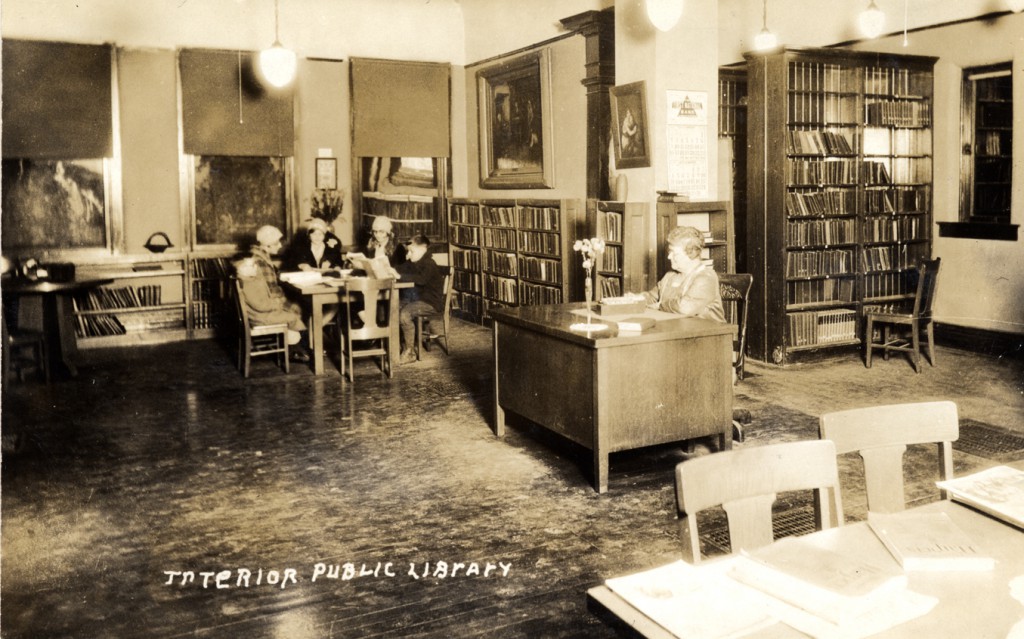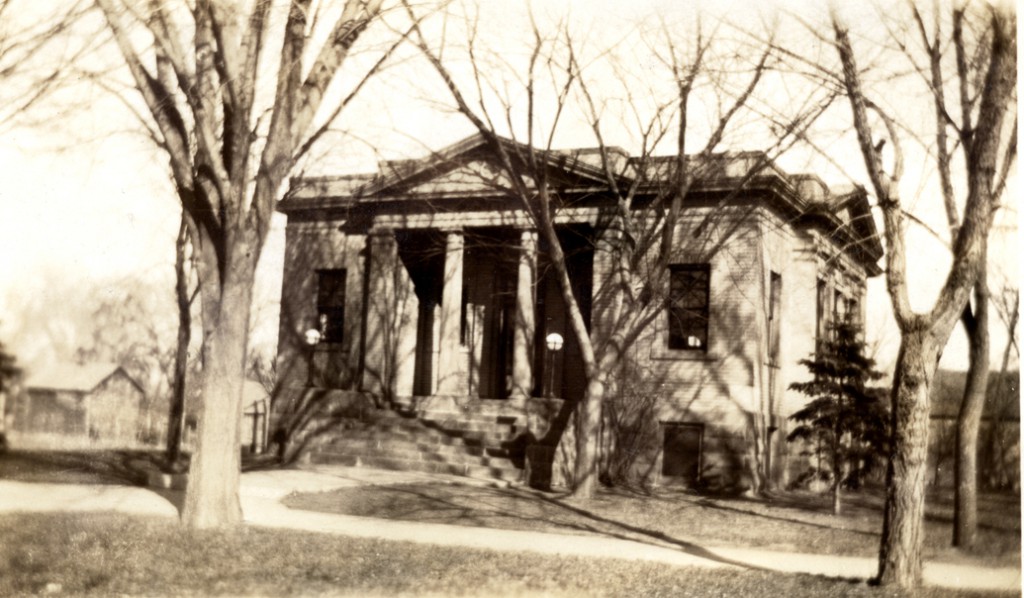Search the Blog
Categories
- Books & Reading
- Broadband Buzz
- Census
- Education & Training
- Friday Reads
- General
- Grants
- Information Resources
- Library Management
- Nebraska Center for the Book
- Nebraska Libraries on the Web
- Nebraska Memories
- Now hiring @ your library
- Preservation
- Pretty Sweet Tech
- Programming
- Public Library Boards of Trustees
- Public Relations
- Talking Book & Braille Service (TBBS)
- Technology
- Uncategorized
- What's Up Doc / Govdocs
- Youth Services
Archives
Subscribe
Monthly Archives: May 2015
NCompass Live: Connecting to your community through the Human Library program: The Pace University Library experience
 Join us for next week’s NCompass Live, “Connecting to your community through the Human Library program: The Pace University Library experience”, on Wednesday, June 3, 10:00-11:00 am Central Time.
Join us for next week’s NCompass Live, “Connecting to your community through the Human Library program: The Pace University Library experience”, on Wednesday, June 3, 10:00-11:00 am Central Time.
This session will provide information on how the Mortola Library at Pace University (Pleasantville, NY) used the “Human Library” program to build community through the sharing of unique experiences from university community members through the “borrowing” of human “books.” Steven Feyl and Phil Poggiali will provide lessons learned from the conceptualization, planning, implementation, and reflection on the program experience.
Upcoming NCompass Live events:
- June 10 – Making The Most of The Cloud
- June 17 – NebraskAccess Expansion
- June 24 – Metadata Manipulations: Using MarcEdit and Open Refine to Enhance Technical Services Workflows
For more information, to register for NCompass Live, or to listen to recordings of past events, go to the NCompass Live webpage.
NCompass Live is broadcast live every Wednesday from 10am – 11am Central Time. Convert to your time zone on the Official U.S. Time website. The show is presented online using the GoToWebinar online meeting service. Before you attend a session, please see the NLC Online Sessions webpage for detailed information about GoToWebinar, including system requirements, firewall permissions, and equipment requirements for computer speakers and microphones.
Posted in Education & Training, Technology
Leave a comment
Friday Reads: Fahrenheit 451 by Ray Bradbury
“Somewhere the saving and putting away had to begin again and someone had to do the saving and keeping, one way or another, in books, in records, in people’s heads, any way at all so long as it was safe, free from moths, silver-fish, rust and dry-rot, and men with matches.”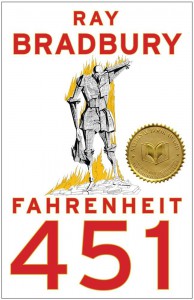
I find it somewhat hard to believe that I haven’t read Fahrenheit 451 until now. In addition to its status as a classic, it would seem that, given, my chosen profession, I’d have managed to read it already. As the above quote illustrates, the message of this book should appeal to librarians.
Before I started reading this book, I was familiar with the general premise, a dystopian future in which books are outlawed. The book’s protagonist is Guy Montag, who works as a fireman. In this future society, firemen don’t put out fires; they set them, in order to burn illicit books. Montag becomes increasingly dissatisfied with the state of the society in which he lives, and he takes steps to oppose the status quo.
I’ve been very pleasantly surprised at how much I’m enjoying finding out all the details of this book that has existed in my consciousness only as a cultural icon all this time. I think it is very well-written, and I love Bradbury’s prose. Although the book was originally published in the 1950s, I find many of its descriptions of everyday life and technology very similar to our current society. Reading about how, instead of interacting with one another, people focus their attention on televisions that take up three walls of their living rooms and constantly listen to earphones made me feel guilty about the amount of time I spend mindlessly using my TV, tablet, and iPod. (However, I did use my iPod to listen to this audiobook, so maybe electronic devices are not all bad!)
The particular audiobook I am listening to is narrated very well by actor Tim Robbins, which adds to my enjoyment. Robbins does a great job of bringing Montag to life and provides distinguishable, believable voices for the supporting characters.
Bradbury, Ray. Fahrenheit 451. Newark, NJ: Audible Studios, 2014.
Sisters in Crime Love Libraries
Did you see that great article in Novelist’s RA News newsletter about the Sisters in Crime organization? This group of women mystery writers will give a $1000 “We Love Libraries” grant to a lucky U.S. public library each month. See the RA News article (and maybe sign up to get the newsletter in your email) at http://www.libraryaware.com/14/NewsletterIssues/ViewIssue/40e4b2e6-de96-4cdf-8c2f-2971bc947165?postId=5854230f-a406-4ff3-a615-77c67ed49f0b. See more about the SinC grant opportunity at http://www.sistersincrime.org/default.asp?page=53.
Throwback Thursday: Interior photo of the Albion Nebraska Carnegie Library
Posted in General, Nebraska Memories
Leave a comment
The Data Dude – Integrated Library Systems
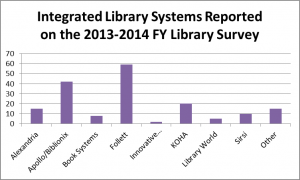 Today, the Dude regurgitates some statistics from last year’s survey (2013-2014) regarding integrated library systems. The leaders (see the chart at the right) are Follett, Apollo (Biblionix), and KOHA (Pioneer Consortium). It should be noted that library needs are different and while one ILS may work real well for one community, it may not be the best choice for another, even when other factors are similar. If you are interested in looking at the data about the ILS your peer libraries are using, you can download the excel file with all the data. Shaka.
Today, the Dude regurgitates some statistics from last year’s survey (2013-2014) regarding integrated library systems. The leaders (see the chart at the right) are Follett, Apollo (Biblionix), and KOHA (Pioneer Consortium). It should be noted that library needs are different and while one ILS may work real well for one community, it may not be the best choice for another, even when other factors are similar. If you are interested in looking at the data about the ILS your peer libraries are using, you can download the excel file with all the data. Shaka.
Free Unbiased Online Financial Education Class Available
FOR IMMEDIATE RELEASE:
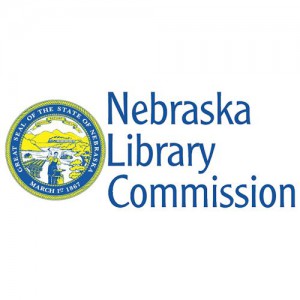 May 26, 2015
May 26, 2015
FOR MORE INFORMATION:
Mary Jo Ryan
402-471-3434
800-307-2665
Free Unbiased Online Financial Education Class Available
Money for college?…for retirement?…to buy a home? Free online financial education classes are available for all Nebraskans.
The Nebraska Library Commission is pleased to announce that access to better financial and investor information resources is now available through a free unbiased online financial education class
offered through the Smart Investing@your library® Builds Nebraska Communities project.
Get a login password at http://nlc.nebraska.gov/FinancialEducation and learn more about how to make informed decisions about budgeting, money management, saving for college, buying a home, retirement planning, and more. This online class is offered as part of a statewide grant awarded by the American Library Association and the FINRA Investor Education Foundation to the Nebraska Library Commission and the Northeast Library System (now Three Rivers Library System). This prestigious grant is helping to build the capacity of Nebraska libraries to provide effective, unbiased financial resources, including Books, DVDs, downloadable audiobooks and ebooks, and access to librarian-selected online sources at http://nebraskaccess.ne.gov/moneyandinvesting.asp.
This program is made possible by a grant from the FINRA Investor Education Foundation through Smart investing @ your library®, a partnership with the American Library Association.
The FINRA Investor Education Foundation supports innovative research and educational projects that give underserved Americans the knowledge, skills and tools necessary for financial success throughout life. For details about grant programs and other FINRA Foundation initiatives, visit www.finrafoundation.org .
FINRA, the Financial Industry Regulatory Authority, is the largest non-governmental regulator for all securities firms doing business in the United States. FINRA is dedicated to investor protection and market integrity through effective and efficient regulation and complementary compliance and technology-based services. FINRA touches virtually every aspect of the securities business — from registering and educating all industry participants to examining securities firms, writing and enforcing rules and the federal securities laws, informing and educating the investing public, providing trade reporting and other industry utilities and administering the largest dispute resolution forum for investors and registered firms. For more information, please visit www.finra.org.
Smart investing @ your library® is a partnership between the Reference and User Services Association (RUSA), a division of the American Library Association, and the FINRA Investor Education Foundation. The program supports public libraries and community college libraries across the country in their efforts to meet financial education needs at the local level. Visit http://smartinvesting.ala.org for details.
The Reference and User Services Association, a division of the American Library Association, is the foremost organization of reference and information professionals who make the connections between people and the information sources, services and collection materials they need. For more information, please visit www.ala.org/rusa. The American Library Association is the oldest and largest library association in the world, with more than 60,000 members. Its mission is to promote the highest quality library and information services and public access to information. For more information, please visit www.ala.org or call (800) 545-2433 ext. 4279.
As Nebraska’s state library agency, the Nebraska Library Commission is an advocate for the library and information needs of all Nebraskans. The mission of the Library Commission is statewide promotion, development, and coordination of library and information services-“bringing together people and information.” Visit http://booksarejustthebeginning.com/ for more examples of how Books Are Just the Beginning at Nebraska libraries.
###
The most up-to-date news releases from the Nebraska Library Commission are always available on the Library Commission Website, http://nlc.nebraska.gov/publications/newsreleases.
Posted in Education & Training, General
Leave a comment
Over $2.6 Million in E-rate Funding Awarded to Nebraska Schools and Libraries
Yesterday, USAC released the first Wave of Funding Commitment Decision Letters (FCDLs) for E-rate Funding Year 2015.
Wave 1 includes $2,619,842.74 in funding commitments for approved Category 1 requests (Voice Services and Internet Access) for 209 Nebraska school and library applicants.
Congratulations to all Nebraska schools and libraries funded in Wave 1!
You can check to see if you have a commitment by using USAC’s Automated Search of Commitments tool.
If you are on the list, watch your mail for your Funding Commitment Decision Letter (FCDL). After you receive your letter, you can go on to the next step in the E-rate process, filing your Form 486. Information and instructions on how to do that can be found on the USAC website.
If you are not on the Wave 1 list, don’t panic! There are many more weekly Waves to come as USAC processes more applications. This is just the start of Funding Year 2015, more approvals are coming.
If you have any questions or need any assistance with your E-rate forms, visit the NLC E-rate webpage or contact Christa Burns, 800-307-2665, 402-471-3107.
Posted in General, Library Management
Leave a comment
Friday Reads: Kitchen Confidential: Adventures in the Culinary Underbelly, by Anthony Bourdain
 I remember hearing buzz about Kitchen Confidential, Anthony Bourdain’s account of what it’s like to work in a restaurant kitchen, shortly after it was published in the summer of 2000. Interviews and reviews that surfaced in the media piqued my interest, but I never got around to reading it at the time. Since then Bourdain’s fame has grown due to his participation in several television series, most notably No Reservations and Parts Unknown. Finally, last week, my husband checked out the eBook edition from Lincoln City Libraries’ OverDrive collection. He laughed so hard he cried as he consumed it nightly before bed, interrupting my reading to share excerpts so frequently that I felt compelled to check out, download, and listen to the audiobook edition, read by Bourdain, himself.
I remember hearing buzz about Kitchen Confidential, Anthony Bourdain’s account of what it’s like to work in a restaurant kitchen, shortly after it was published in the summer of 2000. Interviews and reviews that surfaced in the media piqued my interest, but I never got around to reading it at the time. Since then Bourdain’s fame has grown due to his participation in several television series, most notably No Reservations and Parts Unknown. Finally, last week, my husband checked out the eBook edition from Lincoln City Libraries’ OverDrive collection. He laughed so hard he cried as he consumed it nightly before bed, interrupting my reading to share excerpts so frequently that I felt compelled to check out, download, and listen to the audiobook edition, read by Bourdain, himself.
Early in the book Bourdain describes the life lived by restaurant kitchen workers as a subculture. From his anecdotes, which my husband swears aren’t exaggerations (he cooked for two years while I attended library school), that sounds spot on. This is not a ponderous or philosophical book, though Bourdain does share interesting insights and opinions. The prose is raw, in-your-face, and eloquently crude. As Bourdain reads his own words one imagines this is just the way he speaks in real life, when not restrained by television censors. If profanity bothers you, this is not the book for you!
By the end of the book any illusions the reader might have had that cooking for a living is glamorous will have been completely shattered. Bourdain paints a picture of a physically and psychically hard life, where drug addiction and dysfunction reign. Kitchen crews are described at various times as pirate crews and mercenaries. It wouldn’t be the life for me, but I enjoyed reading about it!
Bourdain, Anthony. Kitchen Confidential: Adventures in the Culinary Underbelly. Penguin Random House Audio Publishing Group, 2001. Internet resource. (Listen to sample)
NCompass Live: IT Security for Libraries
 Join us for next week’s NCompass Live, “IT Security for Libraries”, on Wednesday, May 27, 10:00-11:00 am Central Time.
Join us for next week’s NCompass Live, “IT Security for Libraries”, on Wednesday, May 27, 10:00-11:00 am Central Time.
Most any library can be a target, so join Blake Carver, the Owner of LISHost.org, and get some ideas on how to make your library and your home more secure. Carver covers privacy, as it is closely related to security, and should be taken seriously. He shares many ways to stay safe online, how to secure your browser, PC, and other devices you and your patrons use every day. He also tackles some common security myths, talks about secure passwords and network security, as well as hardware and PC security. Carver discusses security issues that you’ll find in your library as well as tricks sysadmins can do with servers to make things safer for you, and that you’ll never see as an end user.
Upcoming NCompass Live events:
- June 3 – Connecting to your community through the Human Library program: The Pace University Library experience
- June 10 – Making The Most of The Cloud
- June 17 – NebraskAccess Expansion
- June 24 – Metadata Manipulations: Using MarcEdit and Open Refine to Enhance Technical Services Workflows
For more information, to register for NCompass Live, or to listen to recordings of past events, go to the NCompass Live webpage.
NCompass Live is broadcast live every Wednesday from 10am – 11am Central Time. Convert to your time zone on the Official U.S. Time website. The show is presented online using the GoToWebinar online meeting service. Before you attend a session, please see the NLC Online Sessions webpage for detailed information about GoToWebinar, including system requirements, firewall permissions, and equipment requirements for computer speakers and microphones.
Posted in Education & Training, Technology
Leave a comment
Small Business Administration: Get certified as an 8(a) Firm
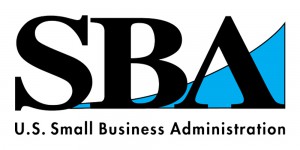 There’s a program that could give your business a big jump in snagging federal government contracts — and the SBA can help you take advantage of it.
There’s a program that could give your business a big jump in snagging federal government contracts — and the SBA can help you take advantage of it.
Why would you want to sell your great products and services to the biggest buyer in the entire world? Here’s eight reasons why getting certified as an 8(a) small business could mean big business.
- The federal government buys everything, from janitorial services to logistics support and everything in between, to the tune of more than $500 billion a year (that’s billion with a B)
- Did you know contracting agencies are required to set aside a certain percentage of all contracts to small businesses, including those with special socio-economic certifications? That gives you the chance to compete with larger contracting firms on a more equal basis.
- If you qualify, you can bid for sole-source contracts up to $4 million for your goods and services, and up to $6.5 million in contracts if you’re a manufacturer.
- You can team up with another business as a joint venture to bid on contracts, allowing you to get more lucrative jobs together as a prime contractor.
- Your business can team up with a more experienced prime contractor and have greater access to financing and successful bids under a Mentor-Protege agreement.
- You can get specialized business training, counseling, marketing assistance and high-level executive development from SBA’s resource partner help that other companies just can’t get.
- Get known to potential purchasers.
- And, by getting certified as an 8(a) firm, you’ll be eligible to buy surplus government property, like desks, computers, tractors, heavy equipment and more, at the same price as government agencies can.
Come learn to see if you qualify, how to apply and leverage your certification.
Sign up now for SBA Certifications: 8(a), Hubzone and ED/WOSB
May 27, 9:30-11:30 a.m.
SBA Nebraska District Office, 10675 Bedford Ave., Suite 100, Omaha
They’ll briefly cover the SBA’s other certification programs, EDWOSB and HUBZone, in addition to the 8(a) program. You will learn:
- Program Details
- Eligibility Requirements
- Benefits
- SBA Assistance to 8(a) firms
- Application process.
Register online at the SBA Event Calendar.
Just Like Riding a Bike
You may not have realized that May is National Bike Month, though I suppose it makes sense to get out and enjoy the spring weather on your bicycle. The first verifiable invention of the bicycle occurred in the 1800s, and as a glance through Nebraska Memories shows, Nebraskans have been enjoying their bikes for many years.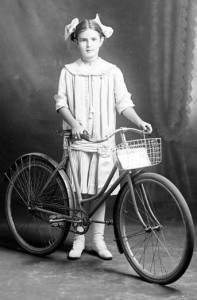
The Butler County Gallery Collection includes some portraits of children posed with their bicycles, such as Elvannah Brown. While she is technically riding a tricycle, rather than a bicycle, this image of toddler Nettie Butler  was too adorable not to include.
was too adorable not to include.
The Townsend Studio Collection also includes some portraits of people with their bikes. This portrait of Mrs. Tomas Bennett most likely depicts a bicycle used for purely recreational purposes, while Ed Mockett’s portrait depicts a cyclist and his racing bike.
A less formal, and more recent, depiction of a bicycle is shown in this image of children at 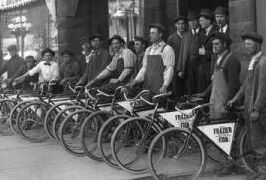 the Nebraska Children’s Home in Omaha receiving a bike, among other gifts, in 1938. Also of interest is a group of images of the Frazier Cycle Company in Omaha in the early 1900s.
the Nebraska Children’s Home in Omaha receiving a bike, among other gifts, in 1938. Also of interest is a group of images of the Frazier Cycle Company in Omaha in the early 1900s.
Visit Nebraska Memories to search for or browse through many more historical images digitized from photographs, negatives, postcards, maps, lantern slides, books and other materials.
Nebraska Memories is a cooperative project to digitize Nebraska-related historical and cultural heritage materials and make them available to researchers of all ages via the Internet. Nebraska Memories is brought to you by the Nebraska Library Commission. If your institution is interested in participating in Nebraska Memories, see http://nlc.nebraska.gov/nebraskamemories/participation.aspx for more information, or contact Devra Dragos, Technology & Access Services Director.
Posted in Nebraska Memories
Leave a comment
Looking for Library Building Grants? USDA to Give Priority Funding for Regional Economic Development Projects
 Agriculture Secretary Tom Vilsack announced yesterday the USDA’s plan to implement a Farm Bill provision that will have a major policy impact on the way the Department helps rural communities plan and finance regional economic development strategies. The new Regional Development Priority (RDP) policy will make it easier for rural communities to access resources to invest in long-term community development efforts by giving priority to applications for Rural Development programs that include regional partnerships and strategies.
Agriculture Secretary Tom Vilsack announced yesterday the USDA’s plan to implement a Farm Bill provision that will have a major policy impact on the way the Department helps rural communities plan and finance regional economic development strategies. The new Regional Development Priority (RDP) policy will make it easier for rural communities to access resources to invest in long-term community development efforts by giving priority to applications for Rural Development programs that include regional partnerships and strategies.
“Regional planning maximizes the effectiveness of our investments in rural America,” Vilsack said here today while addressing the 10th Annual Organization for Economic Cooperation and Development (OECD) Conference. “When communities come together to share resources, ideas and expertise, they can develop a cohesive economy strategy and invest in their future. With a strategy in place, USDA-funded projects can spur regional economic transformation, increase job opportunities and improve quality of life for rural communities.”
Under the RDP, communities with multi-jurisdictional economic development plans will be able to request funding priority when they apply for loans and grants in four key USDA programs. These programs help finance a variety of infrastructure, business and community development needs. They are:
- Community Facilities Program (look for library building grants here)
- Business & Industry Loan Guarantee Program
- Water and Environmental Program and
- Rural Business Development Grant Program.
Applicants seeking priority consideration will be judged by (1) how well their funding request supports a region’s existing development plan, and (2) how well the plan addresses regional collaboration and considers other funding sources including philanthropic groups and other federal agencies. Projects that receive funding will be based on locally identified needs and growth strategies that capitalize upon a region’s unique strengths.
Vilsack made this announcement during the 10th Annual Organization for Economic Cooperation and Development Conference in Memphis, Tenn. The conference brings world leaders and policy officials from 34 countries to discuss how modern policies can help rural regions reach their full economic potential, support national growth and be globally competitive. During the conference, Secretary Vilsack reaffirmed his vision for four pillars of rural economic development.
Additional information about the funding priority was published in today’s Federal Register.
Congress authorized USDA to implement this regional approach when it passed the 2014 Farm Bill. That law builds on historic economic gains in rural America over the past six years while achieving meaningful reform and billions of dollars in savings for taxpayers.
Since the bill’s enactment, USDA has made significant progress to implement each provision of this critical legislation, including expanding access to rural credit, developing new markets for rural-made products, and investing in infrastructure, housing and community facilities to help improve the quality of life in rural America. For more information, visit www.usda.gov/farmbill.
Webinar from Health Happens in Libraries: Launching Community Conversations with Local Health Data
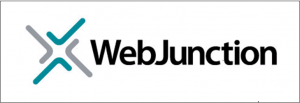 Join this webinar to learn how to build awareness, partnerships and services in support of community health, using County Health Rankings & Roadmaps data and networks.
Join this webinar to learn how to build awareness, partnerships and services in support of community health, using County Health Rankings & Roadmaps data and networks.
Community health data is a powerful tool. It allows public library leaders and local partners to launch conversations and prioritize activities to support community members with reliable health information and services. The County Health Rankings & Roadmaps program provides a comprehensive platform for community based organizations of all kinds to examine and take action on community health data. Attendees at this webinar will learn about ways in which cross-sector collaboration can positively influence social and environmental factors that impact community health. Attendees will also gain familiarity with key features of the County Health Rankings & Roadmaps tool for further exploration of these topics. Attendees will also learn how Buffalo & Erie County Public Library has built awareness, partnerships and services in support of community health, using local data and networks.
Date: 11 June 2015
Time: 2:00 PM – 3:00 PM Eastern Daylight Time, North America
Presenters:
- Kate Konkle, Community Coach, County Health Rankings & Roadmaps and
- Renee Masters, Information Services/Outreach Librarian, Buffalo & Erie County Public Library
Moderated by: Liz Morris, WebJunction
SBA LINC: Help to Access Capital
 There is a demand among entrepreneurs to find financing to get their businesses off the ground or to take the next big step in their expansion plan. Across the country, thousands of small businesses are searching for term loans, equipment financing, lines of credit, invoice financing and real estate loans to help them hire and grow.
There is a demand among entrepreneurs to find financing to get their businesses off the ground or to take the next big step in their expansion plan. Across the country, thousands of small businesses are searching for term loans, equipment financing, lines of credit, invoice financing and real estate loans to help them hire and grow.
This is where technology steps in to meet the demand. Online matchmaking services pairing lenders with prospective borrowers already comprise a multibillion dollar industry. Using the power of the Internet, commercial lenders are finding creditworthy small business borrowers, while entrepreneurs are finding loan officers who are ready to talk with them.
The U.S. Small Business Administration (SBA) is implementing this same matchmaking concept for SBA loan applications. Recently SBA Administrator Maria Contreras-Sweet announced a new SBA initiative called LINC (Leveraging Information and Networks to Access Capital). This SBA matchmaking service will help entrepreneurs connect with a lender.
The SBA spent months surveying their lending partners to discern what information they need from a prospective borrower. They have developed a simple online form with 20 questions that takes just minutes to fill out. Once completed, the form is blasted out to participating SBA lenders in an applicant’s county, as well as financial institutions with a statewide or national reach.
While a positive “hit” won’t ensure entrepreneurs will receive a loan, it will put them on a fast track because they have been pre-screened. If LINC doesn’t produce an immediate match, entrepreneurs will be directed to their local SBA adviser for additional assistance with their loan application.
The LINC matchmaking tool constitutes a huge step toward giving small business entrepreneurs access to essential sources of capital in all 50 states and the U.S. territories.
SBA is committed to becoming as innovative as the small businesses we serve. In the longer term, they also believe LINC could be modified to facilitate government contracting by connecting eligible small businesses with procurement officers, prime contractors and federal buyers. The future is now, and the SBA is proud to embrace technology to help small businesses access the capital they need to stay strong and dream big.
The Data Dude – Wednesday Watch: Memorial Day Edition
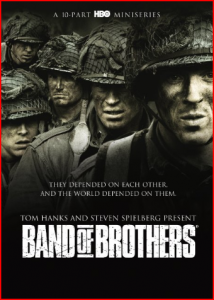 For a Memorial Day edition of Wednesday Watch, let’s talk about Band of Brothers and The Pacific. There are 10 episodes in each of these miniseries offerings from HBO. In order to get the full WWII picture, I think it is necessary to watch both, but I would suggest Band of Brothers first and The Pacific second. Doing so, however, sets the bar high for The Pacific, as Band of Brothers is generally regarded as the better series of the two. Band of Brothers focuses on the WWII European theater, and The Pacific focuses (voila) on the WWII Pacific theater and covers more of the emotional after effects of war in general. I’d argue that The Pacific has a bit more significance because typically the events that occurred there are less known, less written about, and less visualized. The Dude believes that the European theater is more popular for two reasons: (1) since the majority of U.S. citizens migrated from Europe, the countries there are more relatable (consider your knowledge of England and France v.s. the Palau islands (including Peleliu)); and (2) the Hitler effect. As The Pacific illustrates, the fact that the non-European aspects of WWII are less frequently covered in movies and literature doesn’t make them any less dramatic. It should be noted that while both Band of Brothers and The Pacific jibe with most of the actual events, there is some degree of editorial license taken by the producers. These aren’t documentaries, and frankly if you get wrapped up in those minor changes, you miss most of the overall point (hint: it doesn’t really matter). I would suggest that if you are looking for a documentary instead or in addition, watch the fantastic British series World at War. It’s over 22 hours in length, but if you choose to watch an episode per night or week, it is well worth your time.
For a Memorial Day edition of Wednesday Watch, let’s talk about Band of Brothers and The Pacific. There are 10 episodes in each of these miniseries offerings from HBO. In order to get the full WWII picture, I think it is necessary to watch both, but I would suggest Band of Brothers first and The Pacific second. Doing so, however, sets the bar high for The Pacific, as Band of Brothers is generally regarded as the better series of the two. Band of Brothers focuses on the WWII European theater, and The Pacific focuses (voila) on the WWII Pacific theater and covers more of the emotional after effects of war in general. I’d argue that The Pacific has a bit more significance because typically the events that occurred there are less known, less written about, and less visualized. The Dude believes that the European theater is more popular for two reasons: (1) since the majority of U.S. citizens migrated from Europe, the countries there are more relatable (consider your knowledge of England and France v.s. the Palau islands (including Peleliu)); and (2) the Hitler effect. As The Pacific illustrates, the fact that the non-European aspects of WWII are less frequently covered in movies and literature doesn’t make them any less dramatic. It should be noted that while both Band of Brothers and The Pacific jibe with most of the actual events, there is some degree of editorial license taken by the producers. These aren’t documentaries, and frankly if you get wrapped up in those minor changes, you miss most of the overall point (hint: it doesn’t really matter). I would suggest that if you are looking for a documentary instead or in addition, watch the fantastic British series World at War. It’s over 22 hours in length, but if you choose to watch an episode per night or week, it is well worth your time.
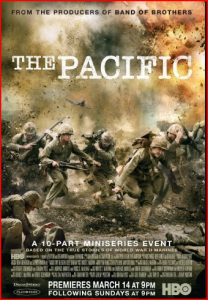 Back to Band of Brothers and The Pacific. I want to make two points. Number one is that for a high school aged kid, I think these should be must watches for the history class. Replacing most (if not all) high school curriculum on WWII with watching these episodes (and perhaps parts of the aforementioned World at War) followed by discussions would make the learning of the events not only more interesting to the students, but give them a more accurate portrayal of the what people went through during this time (on all sides). This is especially true as we are losing many WWII veterans due to age. Also, Band of Brothers in particular teaches more lessons about leadership than any course, book, seminar, or other teaching mechanism that I have experienced. The main example of this is Major Richard “Dick” Winters, portrayed brilliantly by the English actor Damian Lewis. And you wouldn’t realize that he is English because he nails the American accent in Band of Brothers and another stellar series, Showtime’s Homeland. Watch the video. He starts the segment in his non-native accent (American).
Back to Band of Brothers and The Pacific. I want to make two points. Number one is that for a high school aged kid, I think these should be must watches for the history class. Replacing most (if not all) high school curriculum on WWII with watching these episodes (and perhaps parts of the aforementioned World at War) followed by discussions would make the learning of the events not only more interesting to the students, but give them a more accurate portrayal of the what people went through during this time (on all sides). This is especially true as we are losing many WWII veterans due to age. Also, Band of Brothers in particular teaches more lessons about leadership than any course, book, seminar, or other teaching mechanism that I have experienced. The main example of this is Major Richard “Dick” Winters, portrayed brilliantly by the English actor Damian Lewis. And you wouldn’t realize that he is English because he nails the American accent in Band of Brothers and another stellar series, Showtime’s Homeland. Watch the video. He starts the segment in his non-native accent (American).
Posted in General, Library Management, Uncategorized
Leave a comment
Fifteen Summer Readers across Nebraska to Win NEST 529 Scholarships
 FOR IMMEDIATE RELEASE
FOR IMMEDIATE RELEASE
May 20, 2015
Contacts:
Christina Kahler
Director of Marketing, NEST
402-602-6549
ckahler@fnni.com
Mary Jo Ryan
Nebraska Library Commission
402-471-3434/800-307-2665
maryjo.ryan@nebraska.gov
NEST partners with libraries on scholarship program, encourages summer reading
Lincoln, Neb. (May 20, 2015) – Nebraska’s 529 College Savings Plans (NEST), First National Bank of Omaha, Nebraska State Treasurer Don Stenberg and the Nebraska Library Commission announced today the NEST Read to Win $529! Drawing as part of library summer reading programs across the state. Almost $8,000 in NEST 529 College Savings scholarships and more than $3,700 in donations to libraries will be awarded.
The announcement was made during preschool story time at Eiseley Branch Library in Lincoln.
Fifteen summer readers, five in each of Nebraska’s three congressional districts, will be randomly drawn from those who complete a summer reading program. Each winner will receive $529 in a NEST college savings account. The library of each winner will receive a $250 donation. To enter, children must register for the summer reading program at their libraries and complete the program as defined by their libraries.
“This is a perfect partnership for the Nebraska State Treasurer’s Office,” Stenberg said. “We know that children eagerly have been participating in summer reading programs at their local libraries for years without monetary incentives. But the NEST 529 Read to Win! Drawing is an ideal opportunity to recognize summer readers and help them see the connection between reading and learning. Maybe in doing so, we plant a seed for their future educational endeavors and a greater awareness of the benefits of saving through our Nebraska Educational Savings Trust, known as NEST.”
“NEST is proud to support the educational efforts of Nebraska’s children as well as the great work of the libraries statewide,” said Deborah Goodkin, Managing Director of NEST at First National Bank of Omaha, the NEST Program Manager. “With the libraries encouraging leisure reading during the summer, children can daydream and think of places they want to go and what they want to be. We hope this scholarship program encourages children and families to get involved in summer reading and complete the program with a little extra incentive for a possible scholarship.”
“Nebraska public libraries’ summer reading programs are great opportunities for children and teens to have the time to enjoy reading while maintaining and improving reading skills. They can also enjoy the many activities that are part of this year’s Every Hero Has a Story summer reading program,” said Nebraska Library Commission Director Rod Wagner. “As places for learning, libraries are a natural partner for NEST—helping to illustrate the importance of children and their parents setting aside money for college education. The Nebraska Library Commission is pleased to join with the Nebraska State Treasurer, First National Bank of Omaha, Regional Library Systems, and Nebraska public libraries to promote lifelong learning, financial education and planning.”
Winners will be drawn from the names of children who complete the summer reading program as submitted at the end of their programs by libraries throughout Nebraska. Winners will be announced during college savings month in September.
For official scholarship rules, visit the NEST College Savings Plans at www.NEST529.com, the State Treasurer’s Office at treasurer.nebraska.gov/csp/ or the Nebraska Library Commission at http://nlc.nebraska.gov.
###
About NEST
NEST is a tax-advantaged 529 college savings plan and provides four plans to help make saving for college simple and affordable: NEST Direct College Savings Plan, the NEST Advisor College Savings Plan, the TD Ameritrade 529 College Savings Plan, and The State Farm College Savings Plan. The Nebraska State Treasurer serves as the Program Trustee. First National Bank serves as the Program Manager, and all investments are approved by the Nebraska Investment Council. Families nationwide are saving for college using the NEST 529 plans, which have more than 229,000 accounts, including 67,000 in Nebraska. Visit NEST529.com and treasurer.nebraska.gov for more information.
About First National Bank
First National Bank of Omaha is a subsidiary of First National of Nebraska, which is the largest privately owned banking company in the United States. First National and its affiliates have $17 billion in managed assets and nearly 5,000 employee associates. Primary banking offices are located in Nebraska, Colorado, Illinois, Iowa, Kansas, South Dakota and Texas.
About Nebraska Library Commission
As Nebraska’s state library agency, the Nebraska Library Commission is an advocate for the library and information needs of all Nebraskans. The mission of the Library Commission is statewide promotion, development, and coordination of library and information services-“bringing together people and information.” Visit http://booksarejustthebeginning.com/ for more examples of how Books Are Just the Beginning at Nebraska libraries.
Investments Are Not FDIC Insured* No Bank, State or Federal Guarantee May Lose Value
*Except the Bank Savings Individual Investment Option
Posted in General
Leave a comment
NCompass Live: Reading & Sharing: The System Directors Talk About Books
 Join us for next week’s NCompass Live, “Reading & Sharing: The System Directors Talk About Books”, on Wednesday, May 20, 10:00-11:00 am Central Time.
Join us for next week’s NCompass Live, “Reading & Sharing: The System Directors Talk About Books”, on Wednesday, May 20, 10:00-11:00 am Central Time.
The directors of the Nebraska Regional Library Systems, Anneka, Denise, Eric, Scott, and Sharon, get together to do one of their favorite things-talk about the books they’ve been reading. The hour is sure to include some great suggestions-and maybe some surprises.
- Anneka Ramirez, Director, Three Rivers Library System
- Denise Harders and Sharon Osenga, Co-Directors, Central Plains Library System
- Eric Green, Coordinator, Western Library System
- Scott Childers, Director, Southeast Library System
Upcoming NCompass Live events:
- May 27 – IT Security for Libraries
- June 3 – Connecting to your community through the Human Library program: The Pace University Library experience
- June 10 – Making The Most of The Cloud
- June 17 – NebraskAccess Expansion
- June 24 – Metadata Manipulations: Using MarcEdit and Open Refine to Enhance Technical Services Workflows
For more information, to register for NCompass Live, or to listen to recordings of past events, go to the NCompass Live webpage.
NCompass Live is broadcast live every Wednesday from 10am – 11am Central Time. Convert to your time zone on the Official U.S. Time website. The show is presented online using the GoToWebinar online meeting service. Before you attend a session, please see the NLC Online Sessions webpage for detailed information about GoToWebinar, including system requirements, firewall permissions, and equipment requirements for computer speakers and microphones.
Posted in Books & Reading, Education & Training
Leave a comment
Friday Reads: Nemesis by Jo Nesbo
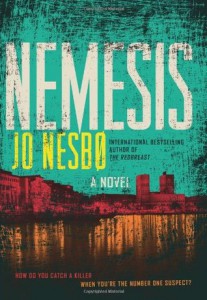 Along with millions of others, I am a fan of Stieg Larsson’s “Millenium” trilogy of crime novels. Seriously, is there a more compelling character than Lisbeth Salander? Those were the first novels I’d read by a Scandinavian author. Having enjoyed Larsson’s series I was curious to learn more about Jo Nesbo, a popular Norwegian author who writes crime fiction – a lot of crime fiction. Harry Hole is the main character in a series of, so far, ten crime novels written by Nesbo. Hole is described as a “classic loose cannon” in the Oslo (Norway) police force. He’s flawed, but, of course, brilliant.
Along with millions of others, I am a fan of Stieg Larsson’s “Millenium” trilogy of crime novels. Seriously, is there a more compelling character than Lisbeth Salander? Those were the first novels I’d read by a Scandinavian author. Having enjoyed Larsson’s series I was curious to learn more about Jo Nesbo, a popular Norwegian author who writes crime fiction – a lot of crime fiction. Harry Hole is the main character in a series of, so far, ten crime novels written by Nesbo. Hole is described as a “classic loose cannon” in the Oslo (Norway) police force. He’s flawed, but, of course, brilliant.
Thus far I’ve read Nesbo’s Nemesis (#4) and The Devil’s Star (#5). Had I known more about the series I would have started with the first book. Even so, the books need not be read in sequence. There’s sufficient detail to fill in the pieces.
Nesbo is a prolific writer. His books have universal appeal (at least for the crime fiction crowd). His books have been translated into over 40 languages and have sold over 23 million copies.
In addition to Nesbo’s Harry Hole novels, he’s written books in series based on other characters (Doctor Proctor, for one). He’s written stand-alone works (Headhunter is another I read recently) and children’s books. He even finds time to be the lead singer for a band performing a hundred or so gigs a year.
Those who enjoy crime fiction, as I do, will find it worthwhile to give Nesbo’s books a try.
How to Set Up a Citizenship Corner at Your Library
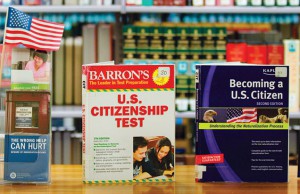 Libraries play an important role in raising awareness about the naturalization process and the rights and responsibilities of U.S. citizenship.
Libraries play an important role in raising awareness about the naturalization process and the rights and responsibilities of U.S. citizenship.
Create a dedicated space in your library where immigrants can find information about becoming a U.S. citizen. USCIS has developed educational materials to help prepare individuals for naturalization. These materials are ideal for setting up a Citizenship Corner in your library. Here immigrants can find the information and resources they need to start the path toward becoming a U.S. citizen.
A typical Citizenship Corner includes citizenship test preparation materials along with information about the naturalization process. Libraries can also add information about community resources, English teaching materials, and other relevant books and videos from their collections. While there are a number of immigration topics that may be of interest to libraries and their customers, USCIS recommends displaying only citizenship and naturalization-related resources in the Citizenship Corner.
How to Set Up a Citizenship Corner at Your Library
- Order one free copy of the USCIS Civics and Citizenship Toolkit. The Toolkit contains immigration and civics publications, handbooks, and multimedia tools. Additional copies are available for purchase through the U.S. Government Printing Office.
- Build your collection by purchasing other USCIS materials. Most of the following publications are also included in the Civics and Citizenship Toolkit:
- The USCIS Naturalization Interview and Test video
- Learn About the United States: Quick Civics Lessons for the Naturalization Test
- Vocabulary Flash Cards for the Naturalization Test
- Civics Flash Cards for the Naturalization Test (English and Spanish)
- Civics and Citizenship Multimedia Presentation
- Download Form N-400, Application for Naturalization and provide copies in the Citizenship Corner. (Remind your customers that all USCIS forms are free.)
- Display and distribute free USCIS informational resources:
- Print 11″ x 17″ citizenship awareness posters in English, Chinese, Spanish, and Vietnamese. Display these posters in the Citizenship Corner, classrooms, and other visible areas.
- Print 6″ x 9″ informational flyers in English, Chinese, Spanish, and Vietnamese. These flyers highlight naturalization eligibility requirements and resources available on the USCIS Citizenship Resource Center.
- Download and distribute the brochure 10 Steps to Naturalization: Understanding the Process of Becoming a U.S. Citizen.
- Download and display the Pathway to U.S. Citizenship poster.
- Enhance your Citizenship Corner with other citizenship-related and English as a Second Language (ESL) resources from your library’s collection:
- Locate the Citizenship Corner near ESL textbooks and resources or post signs directing customers.
- Feature books and magazines that address the content of the 100 civics questions on the naturalization test such as famous Americans, historical events, and important founding documents.
- Arrange your Citizenship Corner to be welcoming and helpful. Here are some additional suggestions:
- Decorate the Citizenship Corner in a patriotic theme.
- Distribute promotional flyers for citizenship or ESL classes offered at your library.
- Distribute flyers from local BIA-recognized organizations that may be able to help immigrant customers with USCIS forms. Visit uscis.gov for more information on finding legal services and BIA-recognized organizations.
- Create and distribute a referral list of local community organizations that provide citizenship services and ESL classes in your community. Start by visiting the Find Help in Your Community page on the USCIS Citizenship Resource Center. Another resource for finding community organizations that offer ESL, civics, and citizenship education classes is America’s Literacy Directory. Search for programs by zip code.
- Add computers to the Citizenship Corner and set the Internet browser home page to www.uscis.gov/citizenship, a one-stop USCIS resource for locating citizenship preparation materials and activities.
- Set up a video monitor at the Citizenship Corner and play The USCIS Naturalization Interview and Test video on a continuous loop.
- Set up a computer workstation that displays Preparing for the Oath: U.S. History and Civics for Citizenship. This interactive website highlights museum objects from the Smithsonian Institution to help people prepare for the civics portion of the naturalization test.
- USCIS often hosts naturalization information sessions and administrative naturalization ceremonies in libraries. View the list of upcoming naturalization information sessions at libraries nationwide. Contact your local USCIS Community Relations Officer if you are interested in USCIS hosting a similar session at your library.
- Create a virtual Citizenship Corner on your library website:
- USCIS offers many free web resources in the Learners section of this site. You may want to add a link on your website.
- Link to USCIS resources by adding a widget to your website. The widgets are small online applications in English and Spanish that can be embedded on social media sites, blogs, or other web pages.
- You can also include information about immigration and citizenship resources available at your library.
